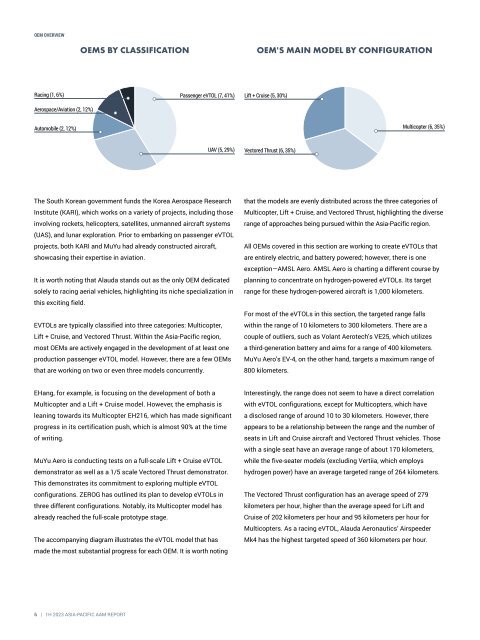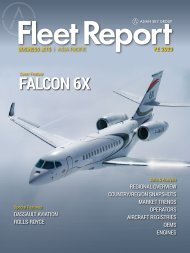Asia-Pacific AAM Report 1H 2023
Create successful ePaper yourself
Turn your PDF publications into a flip-book with our unique Google optimized e-Paper software.
OEM OVERVIEW<br />
OEMS BY CLASSIFICATION<br />
OEM'S MAIN MODEL BY CONFIGURATION<br />
Racing (1, 6%)<br />
Passenger eVTOL (7, 41%)<br />
Lift + Cruise (5, 30%)<br />
Aerospace/Aviation (2, 12%)<br />
Automobile (2, 12%)<br />
Multicopter (6, 35%)<br />
UAV (5, 29%)<br />
Vectored Thrust (6, 35%)<br />
The South Korean government funds the Korea Aerospace Research<br />
Institute (KARI), which works on a variety of projects, including those<br />
involving rockets, helicopters, satellites, unmanned aircraft systems<br />
(UAS), and lunar exploration. Prior to embarking on passenger eVTOL<br />
projects, both KARI and MuYu had already constructed aircraft,<br />
showcasing their expertise in aviation.<br />
It is worth noting that Alauda stands out as the only OEM dedicated<br />
solely to racing aerial vehicles, highlighting its niche specialization in<br />
this exciting field.<br />
EVTOLs are typically classified into three categories: Multicopter,<br />
Lift + Cruise, and Vectored Thrust. Within the <strong>Asia</strong>-<strong>Pacific</strong> region,<br />
most OEMs are actively engaged in the development of at least one<br />
production passenger eVTOL model. However, there are a few OEMs<br />
that are working on two or even three models concurrently.<br />
that the models are evenly distributed across the three categories of<br />
Multicopter, Lift + Cruise, and Vectored Thrust, highlighting the diverse<br />
range of approaches being pursued within the <strong>Asia</strong>-<strong>Pacific</strong> region.<br />
All OEMs covered in this section are working to create eVTOLs that<br />
are entirely electric, and battery powered; however, there is one<br />
exception—AMSL Aero. AMSL Aero is charting a different course by<br />
planning to concentrate on hydrogen-powered eVTOLs. Its target<br />
range for these hydrogen-powered aircraft is 1,000 kilometers.<br />
For most of the eVTOLs in this section, the targeted range falls<br />
within the range of 10 kilometers to 300 kilometers. There are a<br />
couple of outliers, such as Volant Aerotech's VE25, which utilizes<br />
a third-generation battery and aims for a range of 400 kilometers.<br />
MuYu Aero's EV-4, on the other hand, targets a maximum range of<br />
800 kilometers.<br />
EHang, for example, is focusing on the development of both a<br />
Multicopter and a Lift + Cruise model. However, the emphasis is<br />
leaning towards its Multicopter EH216, which has made significant<br />
progress in its certification push, which is almost 90% at the time<br />
of writing.<br />
MuYu Aero is conducting tests on a full-scale Lift + Cruise eVTOL<br />
demonstrator as well as a 1/5 scale Vectored Thrust demonstrator.<br />
This demonstrates its commitment to exploring multiple eVTOL<br />
configurations. ZEROG has outlined its plan to develop eVTOLs in<br />
three different configurations. Notably, its Multicopter model has<br />
already reached the full-scale prototype stage.<br />
The accompanying diagram illustrates the eVTOL model that has<br />
made the most substantial progress for each OEM. It is worth noting<br />
Interestingly, the range does not seem to have a direct correlation<br />
with eVTOL configurations, except for Multicopters, which have<br />
a disclosed range of around 10 to 30 kilometers. However, there<br />
appears to be a relationship between the range and the number of<br />
seats in Lift and Cruise aircraft and Vectored Thrust vehicles. Those<br />
with a single seat have an average range of about 170 kilometers,<br />
while the five-seater models (excluding Vertiia, which employs<br />
hydrogen power) have an average targeted range of 264 kilometers.<br />
The Vectored Thrust configuration has an average speed of 279<br />
kilometers per hour, higher than the average speed for Lift and<br />
Cruise of 202 kilometers per hour and 95 kilometers per hour for<br />
Multicopters. As a racing eVTOL, Alauda Aeronautics’ Airspeeder<br />
Mk4 has the highest targeted speed of 360 kilometers per hour.<br />
6 | <strong>1H</strong> <strong>2023</strong> ASIA-PACIFIC <strong>AAM</strong> REPORT
















